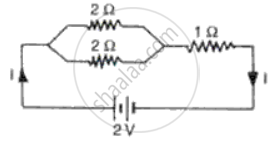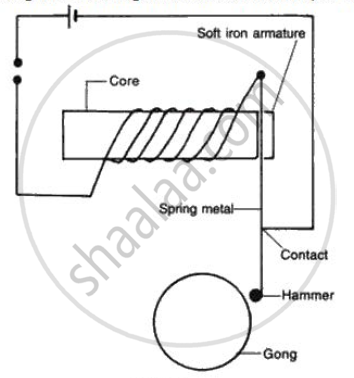Advertisements
Advertisements
Question
What is the current in the circuit shown (Fig. )

Solution
Given, potential difference, V = 2 volt
Let R be the equivalent resistance of the circuit and I be the current flowing through it; then
R = `[(1/2 + 1/2)^-1+ (1)]`
R = [1 + 1] = 2 Ω
`therefore "I" = "V"/"R" = 2/2` = 1 A
APPEARS IN
RELATED QUESTIONS
Define 1 kilowatt hour.
Fig . shows the essent ial features of a battery operated bell. The hammer strikes the gong when the swi tch is closed . State and explain the effect of using the following material successively to form the core.

(a) Plastic
(b) Steel
(c) Copper
Two resistors A and B of 4 Ω and 6 Ω, respectively are connected in parallel. The combination is connected across a 6 volt battery of negligible resistance. Calculate the power dissipated in each resistor.
In an electric radiator or room heater, state with reason, why the porcelain tube wound with a nichrome wire is placed between the pole and principal focus of the parabolic concave reflector.
How does the heat produced by die passage of current in a metallic wire depend on the resistance of the wire.
Find the energy released by a current of 0.25 amperes flowing through a heater for 5 minutes. The p.d. is 230 V.
A bulb is connected to a battery of e.m.f. 6V and internal resistance 2Ω A steady current of 0.5A flows through the bulb. Calculate the resistance of the bulb.
A bulb is connected to a battery of e.m.f. 6V and internal resistance 2Ω A steady current of 0.5A flows through the bulb. Calculate the heat energy dissipated in the bulb in 10 minutes.
